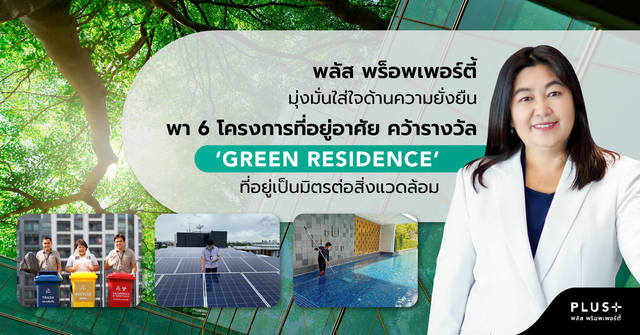PLUS Reveals 6 Trends Driving Real Estate in 2020

6 Trends Driving Real Estate in 2020
Plus Property Company Limited, the full-service professional property and facility management agency, provides an analysis of the trends within the real estate market in 2020. PLUS is keeping its eyes on 6 factors that are driving property development businesses, namely 1) Connected Living Technology. 2) Projects Catering to Real Demand Still Have Room to Grow. 3) Mixed-use Projects Making Headway. 4) Inter-brand Collaboration. 5) Environmentally Conscious Projects. 6) Increased Prominence of Leasehold Properties.
Meanwhile, a survey on property developers’ credibility points to construction quality retaining its place as the most important factor influencing buyer sentiment; usage of quality materials was the second-most important factor.
Ms. Suwannee Mahanarongchai, Deputy Managing Director, Business Strategies and Asset Management, Plus Property Company Limited, the full-service professional property and facility management agency, said 2020 will be another transitional year for the real estate circle when progress must be eked out of a lethargic economy.
Consumers’ purchasing power has yet to become revitalised as Thailand’s household debt remains stubbornly high, and this has been identified as one of the factors contributing to the lethargy in the economy. Within the real estate sector, property developers are shifting their attention to the lifestyles of residents at property projects, in order to attract market share from the group of ‘real demand’ buyers. Plus Property has analysed the trends that are expected to influence the residential property circle in 2020, and discovered 6 factors that carried high momentum.
1. Connected Living Technology
Development projects will, from now on, seamlessly integrate technology to accommodate the lifestyle of the buyer. Linking appliances and devices inside a residence to a smartphone will no longer be a novelty, and will be widely adopted. This is evident at large organisations where there is currently a surge of awareness and a transformative drive toward digitisation; improvement is also being made to software for the purpose of accommodating AI and IoT.
The property sector has been piloting development projects where smart home appliances are linked to AI and IoT. Examples include the use of voice commands via Google Assistant to provide the resident with a ‘smart helper’ at home. Technology has also been brought in to augment the efficiency of buildings and facilities management, in the form of a real-time control center that operates around the clock.
.jpg?frontend_host=https%3A%2F%2Fdigitalplatform.sansiri.com)
Sansiri Smart Home at Setthasiri Krungthep Kreetha 2
2. Projects Catering to Real Demand Still Have Room to Grow
In 2019, low-rise projects gained a more prominent role due to them attracting real demand. This year (2020), however, high-rise condominiums are expected to remain popular provided that they can truly accommodate living demands. Such projects are expected to receive a windfall from new mass rapid transit stations coming into service, with the scheduled completion of extensions on various electric train lines.
This is true for the Green Line and Blue Line rapid transit services. Later in 2020, the Gold Line monorail is slated to open for service. In 2021, the Pink Line and Yellow Line are expected to commence operation. Land along these electric train routes have resultantly become occupied by condominium projects with price tags lower than 100,000 baht per square metre (a unit costing less than 3 million baht).
This category of condominiums make up 70% of all new development projects. Most are found in the outlying areas of Bangkok that include outer Sukhumvit, Chaeng Watthana, Min Buri, Ram Inthra and Ratchada-Latphrao.
.jpg?frontend_host=https%3A%2F%2Fdigitalplatform.sansiri.com)
THE BASE Phetkasem, near the Blue Line metro
3. Mixed-use Projects Making Headway
A real estate development project modeled to serve multiple purposes and possessing office space, retail space, a hotel section and residential space is well-suited for the likes of Bangkok – a metropolis that has limited land available downtown. PLUS’s survey has found that most of the existing mixed-use developments would open for service during 2018-2026.
These projects are expected to bring forth a new standard to the quality of life of people who work in Bangkok, once they are completed and service commences. This is because mixed-use projects possess a distinct edge when it comes to amenities; a full range of amenities is on offer within the project itself. Mixed-use projects also provide occupants with convenience in transportation as each project lays adjacent to a main road and in close proximity to rapid transit.
4. Collaboration Among Various Brands
Inter-brand collaboration is not limited to joint ventures for property development; lifestyle-related brands are also being invited to offer their products or services. An example would be the collaboration between a condominium project and an electric car producer to supply EVs for the condo residents to rent. Another example would be a collaboration between a property project and a convenience store to provide items delivery to residents within the project.
.jpg?frontend_host=https%3A%2F%2Fdigitalplatform.sansiri.com)
Plus Living Management team introducing the Smart Move vehicle
5. Environmentally Conscious Projects
The year 2020 marks another important change in the aspect of environmental awareness. The year heralded the drive to do away with plastic bag handouts at malls, supermarkets and convenience stores, prompting a significant increase in awareness and behavioral adjustment among consumers.
Within the real estate sector, targets increasingly shifted toward developing green projects. Eco-friendly construction materials were seeing increased utilisation, construction methods that generated less debris were increasingly employed, and debris left from construction was being increasingly recycled. Waste disposal at residential projects was also being optimised to better manage uncomsumed items and garbage.
Some residential projects have started making use of innovations to transform waste at the project into fertiliser. At some projects, a part of the common space has been redesigned into plots for growing organic vegetables; the bio fertiliser produced at each project is then utilised at the vegetable plots.
.jpg?frontend_host=https%3A%2F%2Fdigitalplatform.sansiri.com)
Rooftop vegetable plot at Onyx Condominium, under the care of Plus Living Management
6. Leasehold Starts Gaining Prominence
Land for property development is becoming less available, there is a greater tendency for members of the newer generation to remain single, and the population structure has become that of an aging society. These facts mean Thais are increasingly opening up to leasehold properties because they accommodate the buyers’ lifestyle choice of not wanting to have children. Leasehold developments allow the buyer to gain access to condominiums at lower prices than at freehold projects.
Furthermore, the majority of leasehold projects are situated downtown. In addition, leasehold developments with detached houses accommodate the purchasing demand of foreigners who would otherwise be unable to possess land.
In addition to the need to develop projects that cater increasingly to the lifestyles of modern occupants, PLUS also found from its surveys that the professionalism of the property developer constitute an import factor affecting the purchasing decision of consumers. Buyers were found to gauge the credibility of a developer by taking into account the following 5 factors:
1. Good construction quality.
2. Use of quality materials appropriate for the property price.
3. Punctual delivery of the property and a quality of finished product that is in keeping with prior agreements.
4. Presentation of factual information, without exaggerations.
5. Use of new technologies on products and services.
PLUS also surveyed the factors that contribute to residents’ feeling of safety at their properties. The 5 most prominent factors are as follow:
1. Placing importance on good coverage of CCTVs.
2. Availability of anti-burglar alarm or proximity breach alarm.
3. Availability of round-the-clock patrols by security guards.
4. Availability of digital door locks.
5. Employment of keycards or other convenient means for access control.
.jpg?frontend_host=https%3A%2F%2Fdigitalplatform.sansiri.com)
Plus Living Management team inspecting CCTV camera
The findings from the survey indicate that demand for safety-related technologies has become an important influence on the buyer’s sentiment. Although the integration of technology into the residence is a relatively new concept, all signals point to property developers needing to make adjustments to accommodate the changes that will soon come to realisation.
Related news:
-
Plus Hails Living Management Model’s Attractiveness Gains 4 Major Clients as the Year Draws Down
- Plus Creates Curator Program to Distinguish Itself as Leader in Luxury Condos Market Service level
- Plus Notes Prospects for Bang Na-Tra, Finds High Demand for Detached Homes First-half sales of 88%
Plus Property is a full-service professional real estate agency that provides comprehensive assistance in reselling/letting properties and the purchasing of second-hand condominium units. With more than 20 years of experience, PLUS’s team of quality professionals manages residential and commercial properties and also manages projects’ sales and marketing, heeding to all types of demand. For additional information about our services, call 02 688 7555, or click here.

CONTACT PLUS PROPERTY
เรื่องเด่นน่าสนใจ
เรื่องราวยอดนิยม
โครงการแนะนำ
Free E-book
.jpg?frontend_host=https%3A%2F%2Fdigitalplatform.sansiri.com)
5 เทคนิคหาเช่าคอนโดให้สบายใจก่อนแพ็คกระเป๋าเข้าอยู่
ปัจจุบันการหาที่พักอาศัยในเมืองสำหรับคนที่ต้องการความสะดวกสบายในเรื่องการเดินทางการใช้ชีวิตประจำวัน โดยเฉพาะที่อยู่อาศัยประเภท คอนโดมิเนียม กำลังเป็นที่นิยมกันมาก แต่สำหรับคนที่ยังตัดสินใจซื้อไม่ได้ ย้ายที่ทำงานบ่อย หรือมีงบประมาณที่จำกัดในการเลือกที่อยู่อาศัย คู่มือการหาเช่าคอนโดเล่มนี้จากพลัส พร็อพเพอร์ตี้ เปรียบเสมือนเป็นไกด์นำทาง และจะมาบอกเทคนิคดีๆ ไว้ให้คุณหาเช่าคอนโดให้สบายใจตอบโจทย์ทุกความต้องการ







